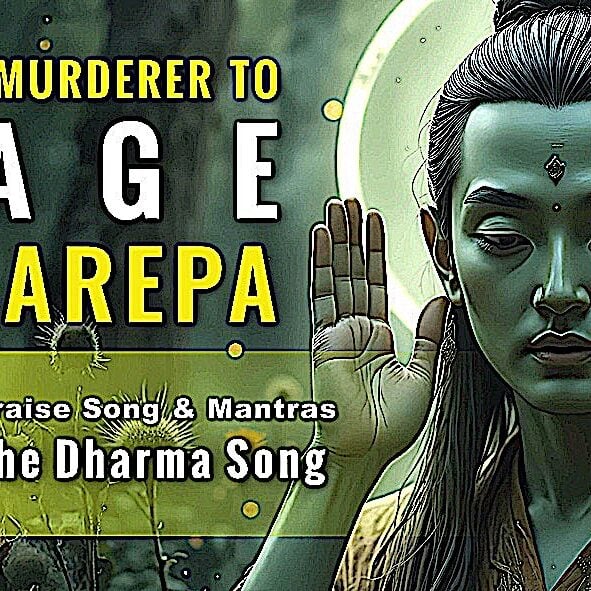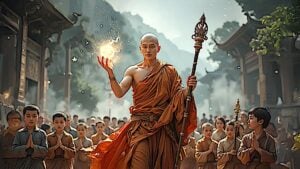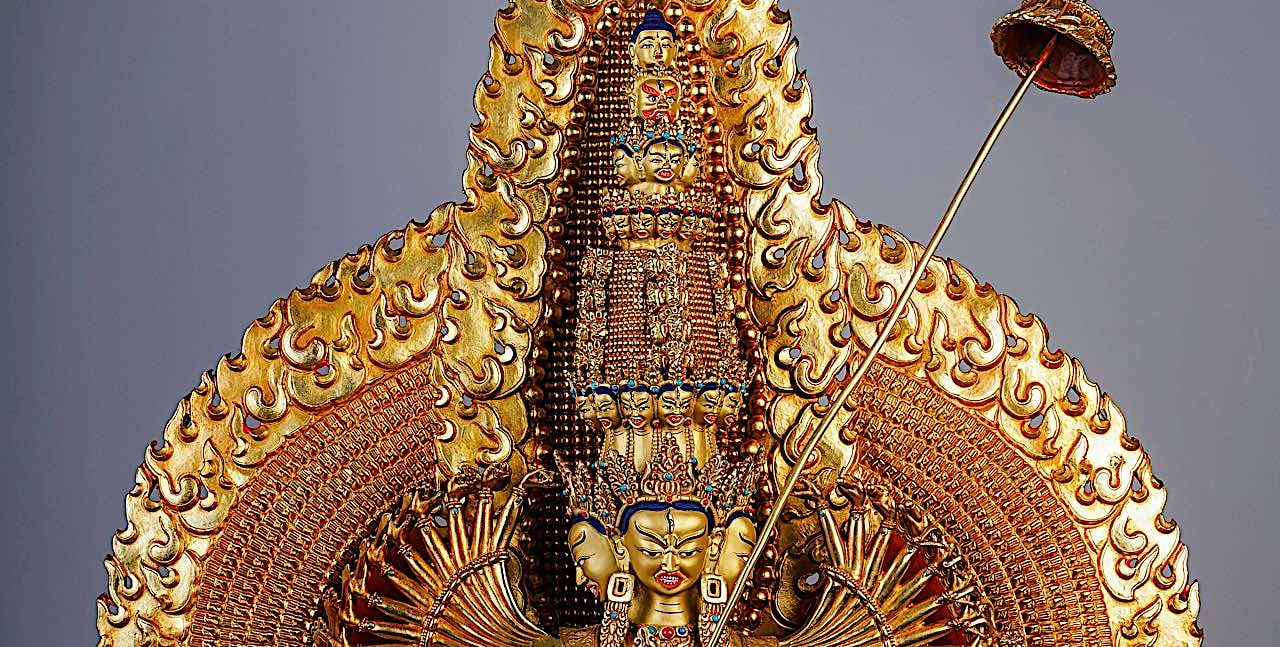Milarepa: from murderer to Enlightened Sage: INSPIRING STORY OF HOPE! and THE DHARMA SONG by 3Gems!
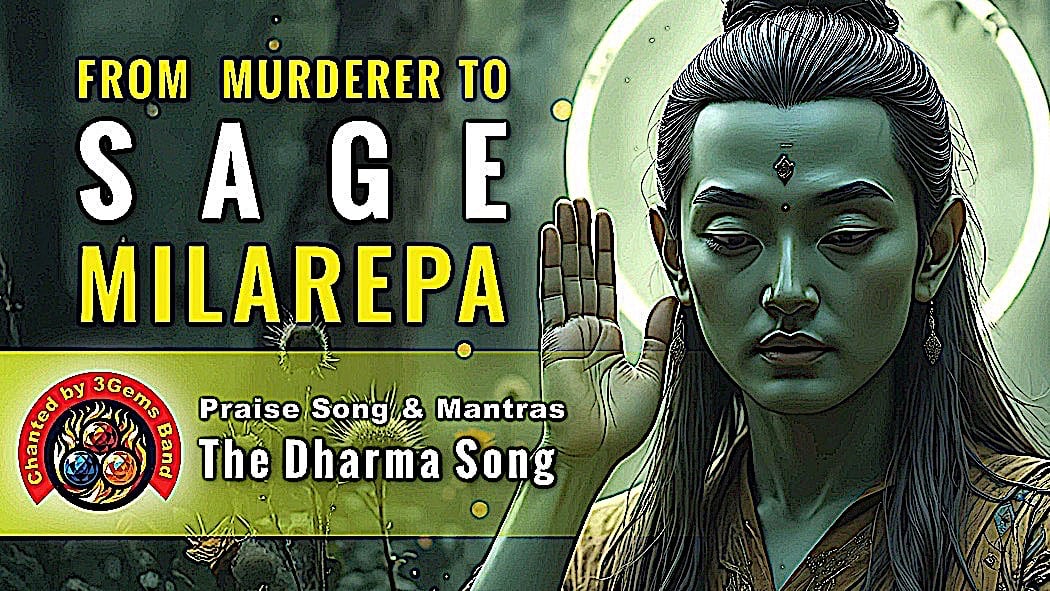
How did a mass murderer and black magician Milarepa become one of the greatest of Buddhist Sages? Why was Milarepa, the great Buddhist Yogi, also known as the Golden-Voiced Singing Sage? Why did he teach with Song? Why did he have green skin? We answer these questions, and end with a beautiful original interpretation of one of the sage’s teaching songs by the 3 Gems Band. SONG INCLUDES SANSKRIT CHANTING OF HIS HEART MANTRA: oṃ āḥ guru hasavajra sarvasiddhi hūṃ
Video:
CONTENTS
00:00 How did a Mass Murderer Become an Enlightened Sage?
01:02 Milarepa’s Epic Story of Revenge and Redemption
02:59 A Life Gone Wrong, Example of HOPE
03:17 Terrible Childhood: “Food for dogs, work for donkeys…”
04:50 Young Topah Takes Revenge — with the Dark Arts
06:20 Milarepa writes about his Despair, seeks a teacher
06:53 He seeks out Marpa, his only hope
07:55 Marpa sets him to work building a stone tower
08:48 Marpa reveals Naropa’s prophecy
09:34 Milarepa finds his mother’s bones
11:02 Milarepa, the nettles and his green skin
12:14 The 100,000 Songs of Milarepa
13:13 SONG OF DHARMA by Milarepa, Sung by @3GemsBand
Jetsun Milarepa’s history is an epic story of grand scope. The essence and beauty of his story remain undiminished by time. With themes of evil and redemption, perseverance, and doing what’s right, Milarepa’s life story teaches us that even the worst of murderers can be purified and transformed with the Buddha Dharma. So great was his transformation, his living life example, that he is considered among the greatest Sages of the Land of Snows.
We honor this legacy with his story, and pay tribute to his great wisdom with 3 Gems Band’s new series of songs performed in modern style, inspired by his 1000 Songs of Wisdom.
Milarepa was an incredibly wise Tibetan yogi, master, and poet who reached enlightenment in his lifetime. Widely considered to be one of the three founders of the Kagyü school of Tibetan Buddhism, he demonstrated through his life that even someone with the horrible karma and guilt of a murderer could become an Enlightened being. His story was one of ordeal, hardship, revenge, sorcery, murder, but leading to a great redemption, Bodhichitta, and Wisdom.
We look to his example of a “life gone wrong” for hope. No matter how badly our lives seem, there is always hope and the opportunity to purify, transform and become great.
He was born Töpah Gah late 11th century. His name means literally “delightful to hear” and in decades to come, he would grow into his name as the Singing Sage with the Golden Voice.
In ancient times, life high up on the Tibetan plateau could never be described as easy; one had to do whatever they could to earn a living and survive. His father died when he was only seven. His father entrusted his estate, including responsibility for his wife, children, and all his wealth and belongings, to his brother and his brother’s wife, until the young Töpah Gah came of age.
The uncle and aunt however, decided they would simply take everything for themselves and keep it, without taking care of Töpah Gah and his family. With nothing to their name, Töpah Gah, his mother, and his sister were forced to work as servants for his uncle and aunt.
Töpah Gah, later known as Milarepa, himself wrote about this part of his life:
“Our food was food for dogs, our work was work for donkeys… Forced to toil without rest, our limbs became cracked and raw. With only poor food and clothing, we became pale and emaciated.”
In hysterics, grief, and desperation, his vengeful mother sent Töpah Gah to train in the dark arts so that he might take revenge upon their greedy relatives. He refused many times, but finally, unable to resist her pleading he did learn black magic under Nubchung Yonten Gyatso.
Conditions became worse. They were not only ignored, but treated almost as animals.
Finally, he did obliterate his aunt and uncle – in a dramatic, vengeful act of vile murder. Thirty-five people, attending a wedding feast at their old family house, were killed in an act of terrifying vengeance.
When the local villagers realized he was responsible, they even threatened him. Again, his mother demanded her own form of useless vengeance, and her sorcerous son sent hailstorms to destroy their crops.
Only then, the young Töpah Gah felt the terrible weight of guilt for the place he called home and the people that he grew up with. In his memoir, he wrote:
“During the day I forgot to eat. If I went out, I wanted to stay in. If I stayed in, I wanted to go out. At night I was so filled with world-weariness and renunciation that I was unable to sleep.”
He despaired, and spiraled into true misery. His guilt became so heavy, he felt certain his only hope now lay in renouncing everything worldly, and even his dark magic, even his vengeful mother. He sought out Buddhist teachers who could help him purify and heal.
Most teacher’s he met felt his burden was too heavy and turned him away. One teacher said to him “Your problem is too complex and troubled. You need to go to great Marpa Lotsawa.”
Marpa Chokyi Lodro was a great Buddhist Sage and translator who lived in Lhodrak in Southern Tibet, and was famous for his fierce temper.
The miserable and sleepless Töpah Gah walked day and night until finally he approached the area. He saw a farmer in his field, toiling over the soil. He did not realize this was Marpa, in disguise, who knew of his coming from a prophetic dream sent by his own great teacher Naropa. He knew the young man’s burden was so massive and dark that he would need extreme purification.
He showered the young man with verbal insults, and set him to work in back-breaking labor that kept his mind focused on physical labor instead of his guilt.
Great Marpa subjected him to a number of ordeals and trials. In one impossible task, Marpa told him to construct a massive stone tower. He then told him it was not good enough and to tear it down and start over. Three times he demanded it be rebuilt.
Only when he built the tower for a fourth time Marpa told him he did not have to tear it down. That tower of stones that Töpah Gah built still stands in the center of Sekhar Gutok Monastery today.
Marpa continued to push his physical and mental limits.
Only when Töpah Gah’s desperation had reached its absolute peak, Marpa revealed to him that Marpa’s own master, the great Indian master Nāropa, had prophesied Töpah Gah’s coming to him in visions. He also told Töpah Gah that these trials and hardships were a means of purification for Töpah Gah’s terrible actions and horrible fixed karma.
Marpa began teaching Töpah Gah more formally. He started with the lay and bodhisattva vows, and gave Töpah Gah the name Dorje Gyeltsen.
He received many tantric instructions that Marpa himself learned in India, but his hardships were to continue. His great teacher Marpa instructed him to spend the rest of his life meditating in solitary mountain retreats. He knew that this would not only benefit his troubled student, but be the cause of benefit for countless others he would encounter in his long life.
Before going to solitude, however, he needed to close the door on his dark past. He had left his vengeful mother behind to seek his redemption. He had to return to visit her. In his own words, we hear of this last devastating scene when he arrived home.
“Then I walked across the doorstep and found a heap of rags caked with dirt over which many weeds had grown. When I gathered them up, a number of human bones, bleached white, slipped out. When I realized they were the bones of my mother, I was so overcome with grief that I could hardly stand it.
I could not think, I could not speak, and an overwhelming sense of longing and sadness swept over me… But at that moment I remembered my lama’s oral instructions. I then blended my mother’s consciousness with my mind and the wisdom mind of the lamas… I saw the true possibility of liberating both my mother and my father from life’s round.”
This was his final push to his lifetime of retreats alone in high mountains.
The most famous of his retreats is one called Drakar Taso, where he stayed for many years eating nothing but wild nettles. He was there for so long that his clothes turned to tattered rags and his bones stuck out of his skin.
It is said that because he ate only wild nettles, his skin turned green. During this time, some starving hunters stumbled upon him and thought him a ghost, until he spoke to them and taught them about happiness, which is one of his 1000 Songs.
It was this period of meditation that gave Dorje Gyeltsen the name we all know him by today: Mila repa, meaning Mila the cotton-clad, due to the rags he wore.
Milarepa wrote many poems and songs that remain great treasures of Tibetan literature during his retreats and meditative periods. Milarepa mastered the Mahamudra teachings and obtained great enlightenment. He never actively sought out students; instead, students found him and he sang and taught them many great wisdoms.
His songs are recorded and translated today in books, such as The Hundred Thousand Songs of Milarepa, available in translations. Although he is known as the golden-voiced sage, no one recorded his notes or music. We do have his verses in Tibetan, now translated, and it is these that the 3 Gems Band took inspiration from to create their new album of songs, the Songs of Milarepa.
Here, we end with a lovely song about why “everyone needs Dharma” from the lowest to the highest of beings, we all need Dharma. Please enjoy this wisdom song, adapted from the great Milarepa by 3 Gems Band. More of there songs are linked at the information icon, or go to their Youtube channel at 3 Gems Band.
oṃ āḥ hūṃ
Now I sing the happy song of Dharma,
A song by the great sage Milarepa
These are the words of the laughing guru
Marpa the translator’s greatest student.
oṃ āḥ guru hasa vajra sarvasiddhi hūṃ
Superior beings need the Dharma
Without it they are like lofty eagles
Even though perched on highest mountain top
They exist only to service their pride.
Average beings have need of Dharma
Without it they are like snarling Tiger
Though possessing great power and courage
They are obsessed only with their hunger.
oṃ āḥ guru hasavajra sarvasiddhi hūṃ
Inferior beings need the Dharma,
Without it they are like sturdy asses
Though they can carry countless possessions
No wisdom or merit do they carry.
Beautiful beings also need Dharma,
Without it they smile vacant and lovely
Always caring about appearances
In time their illusory beauty fades.
oṃ āḥ guru hasavajra sarvasiddhi hūṃ
Older beings have need of the Dharma
Without it they are like old leaning tree
Younger beings have need of the Dharma
Without it they are like a charging bull.
All children also have need of Dharma,
Without it they will meet wrong views, error
Every being has need of Dharma,
Without it we are the blossomless tree.
oṃ āḥ guru hasa vajra sarvasiddhi hūṃ
Those who want to live with meaning
Should practice the Buddhas teaching.
oṃ āḥ hūṃ
Available for STREAMING under band 3Gems Band and album title “Songs of Milarepa”, song title “The Dharma Song”: Spotify, Tidal, Apple Music, iTunes, Instagram/Facebook, TikTok, YouTube Music,Amazon, Pandora, Deezer, iHeartRadio, Claro Música, Saavn, Boomplay, Anghami, NetEase, Tencent, Qobuz, Joox, Kuack Media, Adaptr, Flo,MediaNet
#Milarepa #Mila #SongsofMilarepa #buddha #buddhistmusic #buddhist_chant #buddhistmantra #buddhistsong #buddhamotivation #རྗེ་བཙུན་མི་ལ་རས་པ་ #marpa #marpa_lotsawa #Jetsun_Milarepa #buddhistmusic #佛教誦經音樂
NOTES:
The Hundred Thousand Songs of Milarepa https://amzn.to/4h6s9BJ
by Christopher Stagg (Translator), Tsangnyön Heruka (Preface)
Earlier translation:
The Hundred Thousand Songs Of Milarepa by Garma C C Chang
https://amzn.to/4h5Cden
They managed to regain some wealth through trading, and eventually Dorje Sengge married and had a son, Mila Sherab Gyeltsen
More articles by this author
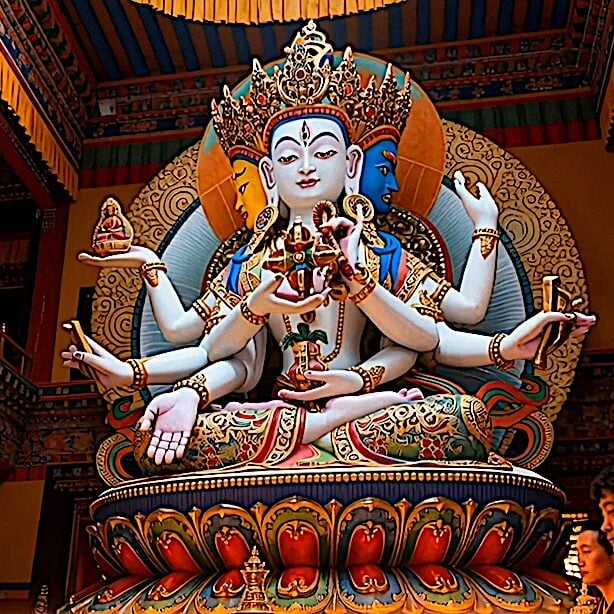
ON HEARING: Ushnisha Vijaya Dharani Overcomes Six Types of Suffering, Conquering the Lord of Death: Supreme in Six Realms
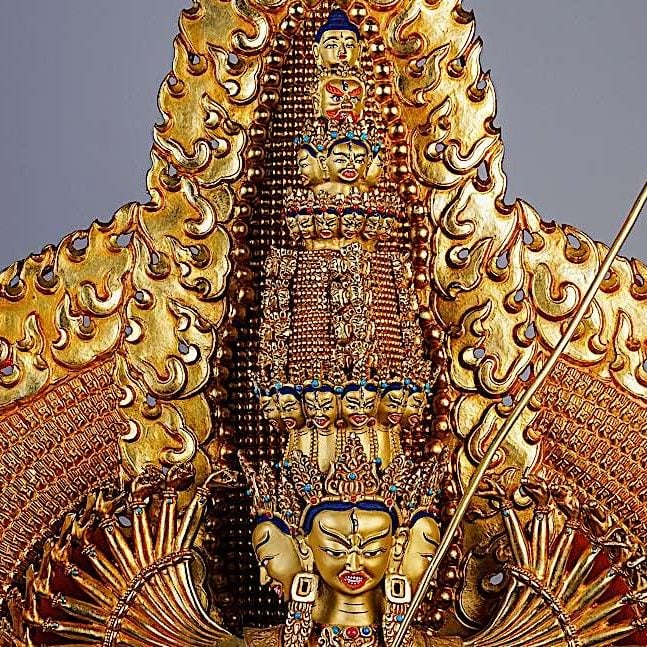
Sitatapatra or Dukkar — the ultimate protective Bodhisattva Goddess, form of Mother Tara — 1000 arms or 2 arms, she is “Aparajita” the Undefeatable One

Sanskrit Wangdu: ✨ Lotus Song of Magnetizing in Sanskrit: Mipham Rinpoche “Accomplish all Wishes” – with Music Video!
Search
Latest Features
Please support the "Spread the Dharma" mission as one of our heroic Dharma Supporting Members, or with a one-time donation.
Please Help Support the “Spread the Dharma” Mission!
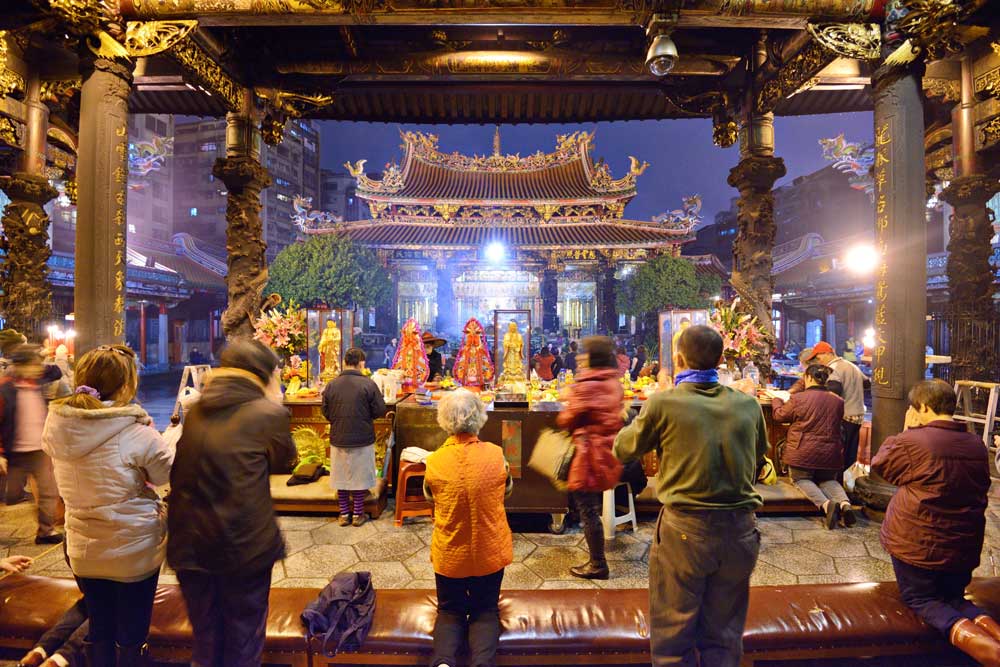
Be a part of the noble mission as a supporting member or a patron, or a volunteer contributor of content.
The power of Dharma to help sentient beings, in part, lies in ensuring access to Buddha’s precious Dharma — the mission of Buddha Weekly. We can’t do it without you!
A non-profit association since 2007, Buddha Weekly published many feature articles, videos, and, podcasts. Please consider supporting the mission to preserve and “Spread the Dharma." Your support as either a patron or a supporting member helps defray the high costs of producing quality Dharma content. Thank you! Learn more here, or become one of our super karma heroes on Patreon.
Lee Kane
Author | Buddha Weekly
Lee Kane is the editor of Buddha Weekly, since 2007. His main focuses as a writer are mindfulness techniques, meditation, Dharma and Sutra commentaries, Buddhist practices, international perspectives and traditions, Vajrayana, Mahayana, Zen. He also covers various events.
Lee also contributes as a writer to various other online magazines and blogs.










